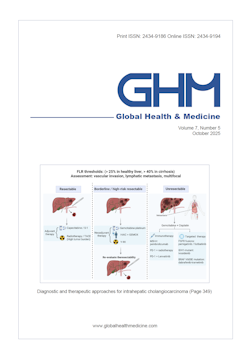Global Health & Medicine 2022;4(4):216-224.
No increased risk of hepatocellular carcinoma after eradication of hepatitis C virus by direct-acting antivirals, compared with interferonbased therapy
Korenaga M, Murata K, Izumi N, Tamaki N, Yokosuka O, Takehara T, Sakamoto N, Suda G, Nishiguchi S, Enomoto H, Ikeda F, Yanase M, Toyoda H, Genda T, Umemura T, Yatsuhashi H, Yamasaki K, Ide T, Toda N, Kanda T, Nirei K, Ueno Y, Haga H, Nishigaki Y, Nakane K, Omata M, Mochizuki H, Aoki Y, Imamura M, Kanto T, Mizokami M
It is well-known that sustained virological response (SVR) by interferon (IFN)-based therapy against hepatitis C virus (HCV) infection reduced the incidence of hepatocellular carcinoma (HCC). However, whether IFNfree direct-acting antivirals reduce the risk of HCC is controversial. Therefore, this study aims to compare the incidence of HCC after the achievement of SVR between sofosbuvir combined with ledipasvir (SOF/LDV) and simeprevir with pegylated interferon plus ribavirin (Sim+IFN). Japanese patients with HCV infection (genotype 1) who achieved SVR between January 2013 and December 2014 by SOF/LDV (NCT01975675, n = 320) or Sim+IFN (000015933, n = 289) therapy in two nationwide, multicenter, phase III studies were prospectively monitored for the development of HCC by ultrasonography for 5 years after the end of treatment (EOT). No HCC was detected before the treatment. HCC was detected in 9 and 7 patients in the SOF/LDV and the Sim+IFN group in 5 years, respectively. The cumulative incidences of HCC rates 1, 3, and 5 years after EOT were similar between the two groups (1.5%, 2.7%, and 3.2% for the SOF/LDV and 1.8%, 2.8%, and 3.0% for the Sim+IFN group, respectively). No HCC was developed 3.5 years after EOT. Interestingly, a retrospective careful review of imaging taken before therapy revealed hepatic nodules in 50% of HCC patients, suggesting HCC was pre-existed before therapy. In conclusion, we could not find any differences in the incidence of HCC after the HCV eradication between the two therapeutic regimens, suggesting no enhancement of HCC development by DAA.
DOI: 10.35772/ghm.2022.01026







